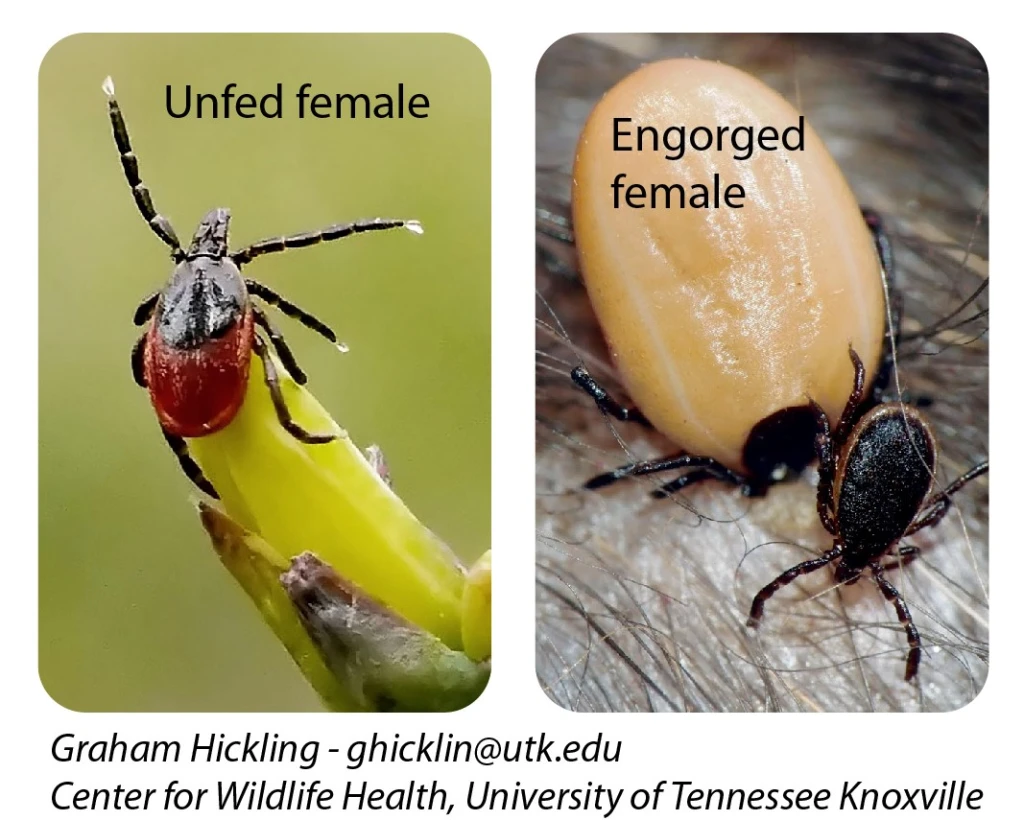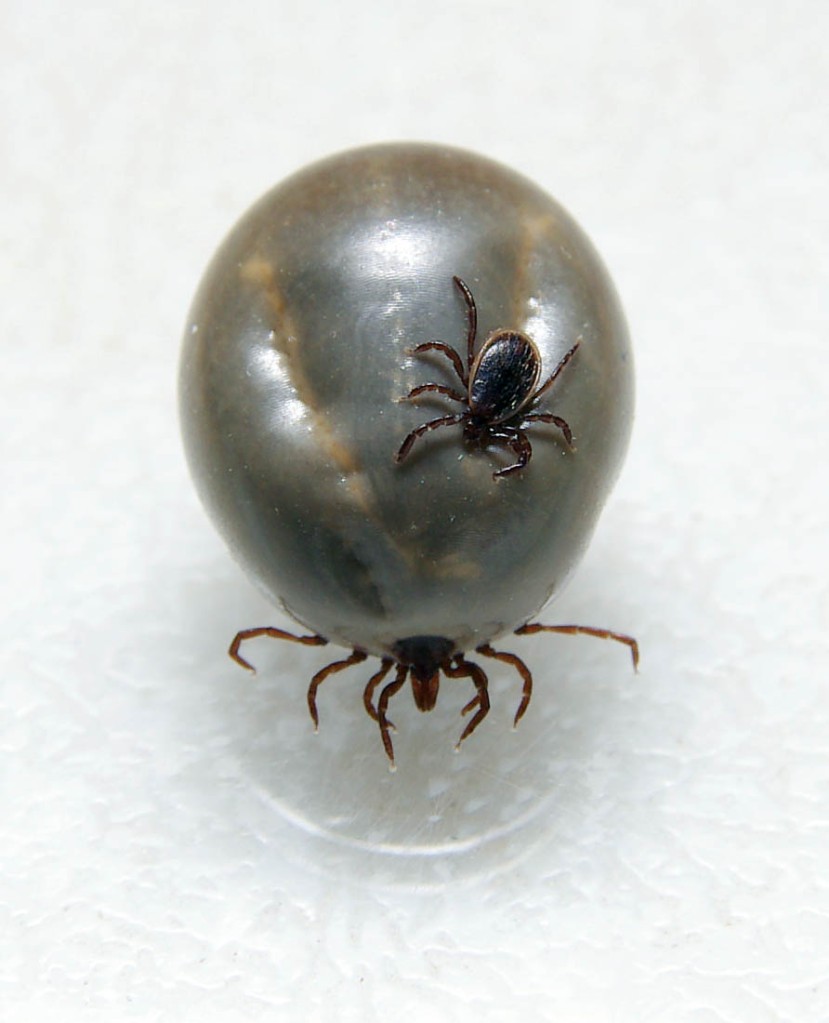Tick FAQ
TICKS
- What are ticks?
Ticks are small insect-like creatures. They feed on the blood of mammals, birds, and sometimes reptiles and amphibians. Adults have eight legs and flat pear-shaped bodies that fill with blood as they feed. Because ticks feed on blood, they can transmit diseases that affect humans and other animals.
Worldwide, there are about 850 tick species and 30 major tick-borne diseases. In the Northeast and Midwest of the U.S. people usually encounter blacklegged ticks, American dog ticks and lone star ticks.
- What are the most common tick species in the U.S. and the most common diseases they can transmit?
| Species | Where? | Associated diseases |
|---|---|---|
| Blacklegged tick/Deer tick (Ixodes scapularis) | Northeastern and upper midwestern U.S. (Also present in the southern U.S., but they are less likely to bite humans) | Lyme disease, anaplasmosis, babesiosis, Powassan disease,ehrlichiosis, and hard tick relapsing fever |
| American dog tick/“Wood” tick (Dermacentor variabilis) | East of the Rocky Mountains and in limited areas on the Pacific Coast of the U.S.. | Rocky Mountain spotted fever and tularemia |
| Lone Star tick
(Amblyomma americanum) | Southeastern and eastern U.S. | Human monocytic ehrlichiosis, tularemia |
| Gulf Coast tick
(Amblyomma maculatum) | Coastal areas and some inland areas of the southeastern and mid-Atlantic U.S. | Rickettsia parkeri rickettsiosis (a form of spotted fever) |
| Western blacklegged tick (Ixodes pacificus) | Along the Pacific coast of the U.S. | Anaplasmosis and Lyme disease |
| Rocky Mountain wood tick (Dermacentor andersoni) | Rocky Mountain states from 4,000 to 10,500 feet. | Rocky Mountain spotted fever, Colorado tick fever, and tularemia |
| Brown dog tick
(Rhipacephalus sanguineus) | Throughout the U.S., but mainly associated with canine-inhabited dwellings | Rocky Mountain spotted fever (southwestern US) |
For a more information on which ticks can be found in your region click here
- How long does a tick live?
Ticks have four life stages: egg, larva, nymph, and adult. Larvae and nymphs need to take a blood meal to molt and grow from to the next stage. Female adult ticks feed on blood to lay eggs, while males feed very little and attach to animal hosts primarily to find a female. Thus, many ticks need to find and feed on at least three hosts in their lifetimes.
The life cycle takes at least a year to complete, depending on the specie and where they live. Unfavorable climatic conditions may delay these processes so that only one life stage can be completed each year. These environmental limitations can extend the duration of the life cycle to as long as 3 years for some tick species.
Life cycle of the blacklegged tick in the northern U.S.: Source: CDC
- When are blacklegged ticks active?
Tick activity depends on the life stage and weather conditions. Different stages are active at different times of the year.
People are most likely to encounter nymphs, which usually go unnoticed because of their tiny size.
Nymphs are most active in the spring and early summer (May-July). In forests, they are mostly found in the leaf litter and on low lying vegetation. Nymphs molt into adult ticks which are most active in the fall (October-November). This general life cycle pattern varies among regions in the U.S. due to differences in environmental conditions. Ticks can be active on winter days when the ground temperatures are above freezing.
- How do ticks survive winter?
During the winter, ticks become dormant, allowing them to survive during unfavorable environmental conditions.
- How do ticks find hosts?
Ticks wait for a host to feed on on the tips of grasses, leaf litter, and shrubs, in a position known as “questing”. They hold the first pair of legs outstretched, waiting to climb on to a host as it passes by. Ticks don’t fall down from trees, jump or fly!
Blacklegged Tick male (Ixodes scapularis; “Deer Tick”) from Wildlife Health on Vimeo.
When a host brushes the spot where a tick is waiting, it quickly climbs aboard. Some ticks will attach quickly and others will wander, looking for places like the ear, belly button or other areas where it is easier to feed (skin is thinner) or it is warm and humid.
Some species, like the lone star tick, display a more aggressive behavior, actively pursuing hosts. They find their hosts by detecting breath and body odors, or by sensing body heat, moisture, and vibrations.
- How do ticks bite?
Ticks feed by latching on to an animal or person, embedding their mouthparts into the host’s skin and sucking its blood. Most people that o get bitten by a tick won’t feel anything because tick saliva has numbing properties. However, some people will feel itching.
Source: Created by KQED San Francisco and presented by PBS Digital Studios
- What does a tick bite look like?
If you are bitten by a tick, a small red bump may appear in a few days to a week, usually at the site of the bite, which may feel warm and tender when touched. This should not be mistaken for the bull’s eye rash which is a hallmark of Lyme disease.
If this tick has transmitted the Lyme disease bacterium, the redness may expand over the next weeks and form a round or oval red rash that is bigger than 2 inches in size. and sometimes there is a a red ring surrounding a clear area and a red center (i.e., the “bullseye”), but often the rash is uniformly red or reddish-blue and is slightly tender and itchy.
- How long does a tick stay attached?
The length of time a tick stays attached depends on the tick species, tick life stage and host response to the bite. Generally if undisturbed, larvae remain attached and feeding for about 3 days, nymphs for 3-4 days, and adult females for 7-10 days.
- What does a blood-fedfed tick look like?
As they take more and more blood, ticks change dramatically in appearance.


- Are all ticks infected with disease-causing microbes?
Not all ticks are infected. Only a portion of ticks will get infected with a microbe that can cause disease in humans. For most pathogens, ticks are born uninfected and only those ticks that feed on an infected host become infected. The state that is most likely to transmit a disease is the nymph. As larvae, they often become infected by feeding on an infected mouse or a chipmunk, but perhaps a shrew or robin. They don’t become infected if they feed on deer, lizard, and less likely if they feed on a raccoon, opossum or catbird. Then after they develop into nymphs, they can transmit a pathogen during their next blood meal.
- How can I know if a tick is infected?
There is no way to know based on appearance: infected and uninfected ticks look the same. In the Tick identification section you can find a list of tick identification and testing services. Important note: Even if the tick is infected, that does not mean you are infected, because infection requires many steps, such as whether the number of pathogens in the tick were high enough or if the tick fed long enough to transmit the pathogen to you. Conversely, even if the tick is not infected, that does not mean you can not be infected; you might have not seen another nymph that was infected and bit you.
Want to know more about ticks? Watch this video!
LYME DISEASE
Disclaimer: The “TickApp” is intended to be informational; it provides no clinical assessments or diagnoses. Please contact your physician if you have any medical concerns.
13. What is Lyme disease?
Lyme disease is an infection caused by Borrelia burgdorferi, a bacterium carried by blacklegged ticks. It is a disease that is becoming more common in the U.S.. Lyme disease is very common in parts of the midwestern and northeastern U.S. states, particularly where ticks can find mice and deer in wooded areas in proximity to humans.
- How do you get Lyme disease?
If a blacklegged tick is infected with the Lyme disease bacterium, the organism can be transmitted with the tick’s saliva as it feeds on the host. In the case of Lyme disease, at least 36 to 48 hours of feeding is typically required for a tick to transmit the bacterium. This may be shorter if multiple ticks are feeding at the same time.
- Is there a vaccine against Lyme disease?
Unfortunately, there is currently no vaccine available to protect people from Lyme disease. A Lyme disease vaccine was available until 2002 but was discontinued by the manufacturer.
- What are the symptoms of Lyme disease?
Within about one month after infection, Lyme disease often shows up with a red rash (usually expanding from the site of the tick bite), headache, fever, and sometimes joint pain. The rash, called erythema migrans, is a hallmark of Lyme disease and appears in about 70-80% of infected people.

- When should I go to the physician?
Always seek medical care if you are not feeling well.
The appearance of an expanding red rash accompanied by other symptoms, such as fever, headache, fatigue and/or muscle and joint pains, may be signs of early Lyme disease, particularly during early summer and for people who live in blacklegged tick infested areas. Seek prompt medical attention if you encounter an attached tick, remove it, and take the tick with you to the health care center so that the tick can be identified and proper treatment administered.
If diagnosed and treated early with antibiotics, Lyme disease is usually curable. In its later stages treatment can be effective; some patients may have symptoms that linger for months or even years following treatment.
- Other tick-borne diseases: What about babesiosis and anaplasmosis?
Anaplasmosis and babesiosis are also transmitted by the blacklegged tick. Anaplasmosis is caused by the bacterium Anaplasma phagocytophilum, and babesiosis is caused by Babesia microti, a microscopic parasite that infects red blood cells. Typical symptoms of either of these infections include fever, headache, chills, and muscle aches. Usually, these symptoms occur within 1-2 weeks of a tick bite in the case of anaplasmosis. In the case of babesiosis symptoms usually develop within a few weeks or months, sometimes longer.
Anaplasmosis and babesiosis can lead to serious illnesses even in previously healthy people.
More information on these and other tick-transmitted disease can be found here.
- I read in the news that you can get a meat allergy from a tick bite – is this true?
Yes, in some cases bites from lone star ticks can lead to red meat allergies due to the body’s reaction to tick saliva. This allergy is characterized by hives or a severe allergic reaction appearing 4–8 hours after meat consumption. The carbohydrate alpha gal (galactose-alpha-1,3-galactose), which is found in red meat, is the likely cause of the reaction.
More information here.
PETS
20. Do dog and cats get Lyme disease?
Yes. Just as with humans, it is important for animals to avoid tick bites and receive prompt treatment for Lyme disease. Symptoms of Lyme disease in animals are similar to the symptoms in humans.
In dogs: Symptoms include lethargy, arthritis (displayed as joint pain, shifting from foot to foot, and lameness), fever, fatigue, and kidney damage. The majority of dogs do not experience any signs of disease.
In cats: While there is some debate about whether cats suffer from Lyme disease, cats are thought to be highly resistant to the disease.
Sources used throughout the development of the Tick FAQ:
